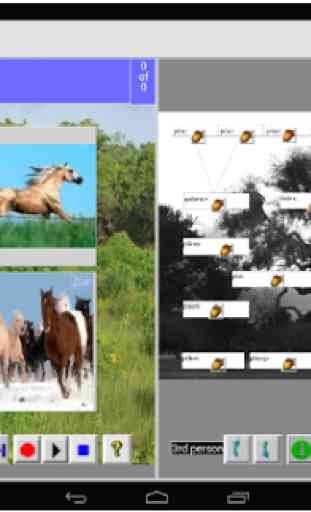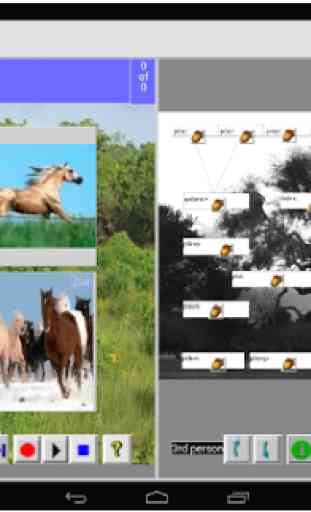ACORNS Mobile Player
The purpose of this project is to support the language revitalization efforts of Native American tribes, hence the name: [AC]quisition [O]f [R]estored [N]ative [S]peech. The acorn is sacred to the tribes of Northern California and Southern Oregon. The name ACORNS honors those tribes that helped spawn this effort.
ACORNS desktop software (freely downloadable from http://cs.sou.edu/~harveyd/acorns) allows language instructors and students easily to prepare and execute language learning lessons. The ACORNS mobile player maintains a gallery of these lessons and executes them on Android compatible devices. Once the ACORNS mobile player application is installed, it launches when it receives an ACORNS lesson by email attachment, through a cloud-based service (i.e. Drop Box), or through a Web download link address. ACORNS lesson files have an .acorns extension,
Presently, ACORNS software supports ten types of language learning lessons. A short description of each follows:
1) Picture and Sound lessons contain a background image with attached written and spoken words at various places. When students click a place on the picture where there is an attached recording to hear a description of it in the native language along with culturally relevant information.
2) Multiple Choice lessons are games similar to those found in commercial language acquisition products. Each lesson consists of a group of pictures. To each picture, a group of recorded audio is attached. When students execute these lesson they will see four images displayed on the screen, then hear a phrase describing one of the pictures. Their task is to click the correct picture.
3) Story Book lessons playback a piece of a story and display a picture that relates. Each lesson represents a page linked together to form an entire story book. Students listen along and watch the captions highlight words during the playback.
4) Magnet Game lessons display a series of magnets, each containing a word from a sentence. Students drag the magnets over adjacent words, which cause the magnets to merge. The goal is to reconstruct a group of sentences. After students succeed, they can click on the completed magnet, which now contains the entire sentence, to hear audio, see a picture, and also view additional descriptive information.5) Hear and Click lessons consist of an audio recording of a story annotated with still and animated pictures. The student hears the story and sees a random selection of pictures scattered around the display. Their goal is to click on the appropriate picture as the story plays back.6) Flash Card lessons contains three piles of cards. Initially all of the cards are in the leftmost pile. The student's job is to correctly identify audio expressions that go with the cards. After enough correct answers, cards move to the middle pile. After more correct answers, the cards go to the rightmost pile. The goal is to get all the cards to the rightmost pile.7) Pictionary lessons show a group of pictures that relate to category of sentences or phrases used in conversation. Students click on these to hear a representative sentence and also see descriptive information that is displayed.8) Hear and Respond lessons contain alengthy sound recording (like a story or a speech) annotated with its composite words and phrases. The annotations show up on a student's screen as a transcript of the recording, but some of the words are left blank. Students listen to the recording and fill in the blank words and phrases as it plays.9) Moving Pictures lessons display four pictures at a time that move about the display window. Students click to hear attached audio. Periodically, every twenty or thirty seconds, the pictures change.10) Question and Answer lessons involve a fluent speaker who poses questions to the student. Each question may have multiple correct answers. The student's job is to correctly answer each question appropriately.
ACORNS desktop software (freely downloadable from http://cs.sou.edu/~harveyd/acorns) allows language instructors and students easily to prepare and execute language learning lessons. The ACORNS mobile player maintains a gallery of these lessons and executes them on Android compatible devices. Once the ACORNS mobile player application is installed, it launches when it receives an ACORNS lesson by email attachment, through a cloud-based service (i.e. Drop Box), or through a Web download link address. ACORNS lesson files have an .acorns extension,
Presently, ACORNS software supports ten types of language learning lessons. A short description of each follows:
1) Picture and Sound lessons contain a background image with attached written and spoken words at various places. When students click a place on the picture where there is an attached recording to hear a description of it in the native language along with culturally relevant information.
2) Multiple Choice lessons are games similar to those found in commercial language acquisition products. Each lesson consists of a group of pictures. To each picture, a group of recorded audio is attached. When students execute these lesson they will see four images displayed on the screen, then hear a phrase describing one of the pictures. Their task is to click the correct picture.
3) Story Book lessons playback a piece of a story and display a picture that relates. Each lesson represents a page linked together to form an entire story book. Students listen along and watch the captions highlight words during the playback.
4) Magnet Game lessons display a series of magnets, each containing a word from a sentence. Students drag the magnets over adjacent words, which cause the magnets to merge. The goal is to reconstruct a group of sentences. After students succeed, they can click on the completed magnet, which now contains the entire sentence, to hear audio, see a picture, and also view additional descriptive information.5) Hear and Click lessons consist of an audio recording of a story annotated with still and animated pictures. The student hears the story and sees a random selection of pictures scattered around the display. Their goal is to click on the appropriate picture as the story plays back.6) Flash Card lessons contains three piles of cards. Initially all of the cards are in the leftmost pile. The student's job is to correctly identify audio expressions that go with the cards. After enough correct answers, cards move to the middle pile. After more correct answers, the cards go to the rightmost pile. The goal is to get all the cards to the rightmost pile.7) Pictionary lessons show a group of pictures that relate to category of sentences or phrases used in conversation. Students click on these to hear a representative sentence and also see descriptive information that is displayed.8) Hear and Respond lessons contain alengthy sound recording (like a story or a speech) annotated with its composite words and phrases. The annotations show up on a student's screen as a transcript of the recording, but some of the words are left blank. Students listen to the recording and fill in the blank words and phrases as it plays.9) Moving Pictures lessons display four pictures at a time that move about the display window. Students click to hear attached audio. Periodically, every twenty or thirty seconds, the pictures change.10) Question and Answer lessons involve a fluent speaker who poses questions to the student. Each question may have multiple correct answers. The student's job is to correctly answer each question appropriately.
Category : Education

Related searches




Wouldn't open